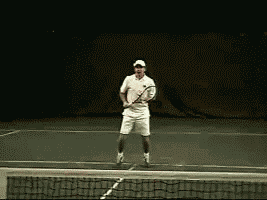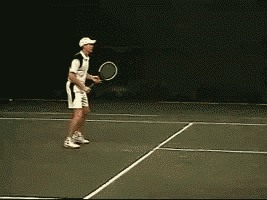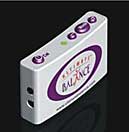|
TennisOne Lessons |
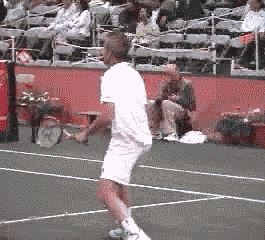 John McEnroe keeps in balance before, during and after this approach volley. |
This last installment of the series focuses on balance in the forecourt, where motion, efficiency, and anticipation are the essential elements of successful volleying.
Since September 2000, when Pete Sampras rested his seven years of dominance in the game as undoubtedly the greatest serve-and-volley player ever, the fine art of moving in to the net and finishing an opponent with touch and agility has taken a back seat to the awesome baseline force of Marat Safin, Andre Agassi, Andy Roddick, Gustavo Kuerten and Lleyton Hewitt.
This is in contrast to the tennis boom of the 1970s, when the #1 ranks were dominated by serve-and-volley players, including legends like John Newcombe, Stan Smith and Ilie Nastase and the modern games of John McEnroe, Boris Becker, Stefan Edberg, Patrick Rafter and Sampras. This year, we are seeing a #1 player - Roger Federer - again venturing to the net, showing the baseliners just how vulnerable they can be to a forward opponent and a well-placed volley.
Though Sampras held the #1 slot almost twice as long as any other player in the last 40 years, the player who truly transformed the volley was John McEnroe.
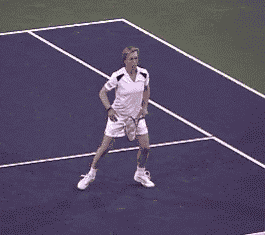 Martina Navratilova demonstrates the effectiveness of quick footwork and economy of upper-body motion. |
What made McEnroe's volley so incredible was that, at a time when almost every top coach was teaching players to lean in and hit volleys out in front, Mac stood in perfect vertical body alignment, dropped his eyes rather than his head to see the ball, and let the ball come to his racquet, making his volleys look effortless. He moved from his hips and legs first, lunging his upper body only as a last resort. This left him poised to finish off the point with a perfect touch just where his opponents didn't want to see it.
In the women's game, we need to reach back to the 1970s and even the 1960s to find serve-and-volley champions like Billie Jean King, Yvonne Goolagong and Martina Navratilova.
The top women today are hitting harder than ever, but only venturing to the net out of necessity, not strategy. There is a great opportunity for them to take away the time the great baseliners need to hit with maximum force and, instead of battling with them, use the angles left open by their baseline opponents to control the play.
So what can we learn from the John McEnroe and Martina Navratilova model of effortless volleying? Balance difficulties at the net are primarily caused by two problems:
- Insufficient footwork and the upper body lunging it causes, which result in bending at the waist and moving the hips away from the shot.
- Tracking the ball with the head and shoulders, rather than leveling the head and tracking the ball with the eyes.
These problems can be overcome by quieting the upper body, which improves depth perception, allows more quickness and accuracy, forces better footwork, and opens the player to quicker anticipation.
Quickness and Accuracy
It takes about one second for a baseline groundstroke to reach a player at the net (versus 2.5 - 3 seconds from baseline to baseline). The preparation, stroke and recovery at the net must be abbreviated since a player can expect to hit another shot about two seconds later. This means that a player needs quick hands, quick feet, quick recovery, and quick reaction to be successful. Together, these four elements allow a player to more successfully finish points at the net.
Quick feet and quick recovery help a player get in position to volley. Quick reaction and quick hands give a player more options to put away the volley. Quickness is a natural result of a body in balance. An out-of-balance player is slow because he has to undo what forced him to become off-balance before he can take action on the present shot, leaving little or no time to actually set up and hit.
With less time to react to a shot, accuracy and feel are paramount for volleyers.
What often draws a player off-balance are unconscious movements that he assumes will help him hit a better shot. Many players use too much upper body rotation and too big a swing at the net. They try to “put the ball away” instead of seeing most volleys as touch shots. Too much rotation leaves the player stuck sideways when the ball returns, forcing him to use just his arm to swing, with no support or drive from the hips.
Others lead their motion with their head, which forces them to lean too far forward. They misinterpret the age-old coaching technique of “watching the ball,” tracking it with their head and shoulders with eyes locked forward (breaking the first rule of coordination from Article One, which says that the head must stay level and the eyes track the ball for clear vision and depth perception). Ironically, lunging the head forward to see the ball causes vision to be blurred and depth perception lost.
Leaning can also be a misinterpretation of “hitting out in front,” in which the player leans and hits out of his reach rather than in front (reminding us of the old adage -- never reach for what will come to you). To compound this problem, leaning toward a shot causes a player's center of gravity – his hips – to move away from the shot, leaving him bent at the waist and dependent only on the power in his arm and shoulders.
|
Power still comes from the hips in volley tennis, but unlike the power in groundstrokes, the hips move directly toward the ball. A great volleyer attacks like a linebacker, straight in with his hips and shoulders forward, only turning and lunging as the ball tries to get by. This lets a player control placement of the shot with his arm and hand, and still gets full power from his hips.
John McEnroe, a master volleyer and stroke pioneer, moved to the ball with his whole body and put his racquet where the ball was, with very little upper body motion. He watched the ball, didn't lean to hit it, and moved forward through the volley. Moving forward like this gave him the opportunity to use a more efficient, compact swing, producing a quick knifing action that created more opportunities for angles and touch shots.
Footwork
Footwork is as important in the forecourt as it is in the backcourt. In the forecourt, I call this footwork the “dance of the volley.” Essentially, this is a forward/backward “dance” that allows a player to maintain his balance and recover quickly for his next shot. Watch professional tennis players warm up at the net; this is an excellent illustration of the dance of the volley. The ball comes and goes from them with fluid precision as they step in and back for each shot.
This forward-and-backward dance is essential for developing top volleys. By reaching forward to hit a volley, a player moves his head and shoulders down and forward, pulling his hips and center of gravity in the opposite direction. If a player has to move any distance at all to hit the ball, he leans and goes off-balance, creating additional steps after the hit and a slower recovery – and there is no time for that at the net!
To maintain balance during volleys, the player's hips must stay just ahead of his shoulders so that, as he steps to hit, he pushes back off that step and can recover simultaneously. Like a game of hopscotch, the player hops in to hit and out to recover and does not reach for the ball, but rather hits the ball in his ideal hitting zone, where his arms are comfortable (see Sit-and-Hit drill in the first installment of this series).
Anticipation
The dictionary defines anticipation as the ability to foresee or expect something to happen. Many people equate this with guessing or taking a calculated risk. In tennis, however, anticipation is the ability to respond instantly. It is not pre-thinking, but using past knowledge, observation, and preparation to respond to an opponent's movements and shots.
|
Click photo to view: McEnroe draws his opponent out of position with his first volley and finishes to the open court. |
Because the volley happens so quickly, anticipation is essential. In the past, anticipation in tennis often amounted to a calculated guess, which left a player lunging his upper body in one direction or the other as he guessed where his opponent would try to hit by him. With a strong inner sense of balance, anticipation occurs simultaneously with action. By the nature of guessing, a player takes action on an assumption rather than the truth. In so doing, he has already overreacted and, when the true shot is hit, he must re-react and change his momentum. We all know the experience of guessing correctly and jamming the ball, as well as missing it because we overran it.
Master volleyers rarely go for winners on the first volley; they instead use their first volley to draw their opponents well out of position, and finish to the open court on the second. This has two advantages: the volleyer hits high-percentage volleys, and the baseliner has to hit a perfect pass to survive, which is a very low-percentage shot. Only off-balance volleyers must go for a winner on the first volley, knowing they will unlikely be back for a second.
When hit on balance, the volley is one of the most graceful and beautiful strokes in tennis. Tennis players with the necessary quickness, accuracy, footwork and anticipation to maintain balance in the forecourt are more likely to be able to put away shots and win points at the net.
Net Volley Drills
Below are drills that players can use to improve their balance at the net. These drills, which can be done with or without the Ultimate Balance Trainer, help teach players how to improve their balance and develop a quiet upper body as they approach and play volley tennis. Part of the challenge is that, for many even advanced players, the correct motion does not initially “feel” right if they have been previously playing off-balance (and trying to compensate for it by extra upper-body motion).
|
Click photo to view Drill 1 - Hopping in and out of the service box. |
The Ultimate Balance Trainer (www.ultimatebalance.com) addresses this problem through instant feedback during motion. This allows much faster improvement to occur through feedback and repetition, so the tennis instructor can focus on teaching strokes and strategy.
Drill #1 – Hopping In and Out of the Service Box
Problem: Do you find that you aren't ready for more than one or two volleys during a point? Do you swing too much and recover too slowly for a quick exchange at the net in doubles? Do you find yourself standing and watching your volley shots or falling off-balance, unable to recover and get ready for your next shot?
Drill: Start just behind the service line in a ready-to-volley stance. As you hit your volley, step inside the service line and land your foot on the ground at the point of contact. Instead of using a heavy foot as you land, act as if you are playing hopscotch and bounce right back behind the line, so that by the time your opponent hits the ball, you are back where you started. The only way to hit inside the line at contact and then be behind the line when your opponent hits, is to keep your shoulders slightly behind your hips. This is a drill for players at all levels.
|
Click photo to view Drill 2 - Two steps in, one step back. |
Drill #2 – Two Steps In, One Step Back
Problem: Do you often net your volleys as you try to move in at the net? Do you try to get to the net as quickly as possible? If so, you probably move toward the net, but then stop your feet, causing you to bend at the waist, lean forward, and hit your shot into the net. Or, you simply lunge too far out in front when you hit, creating too much forward lean.
Drill: This drill takes the balance you learned in Drill #1 and shows you how to move in to the net with balance. Start behind the service line and take two steps toward the ball, creating forward momentum. As you land your foot as you hit, bounce back slightly to a ready position. Now you are ready to move in any direction. When the next shot comes, move two steps forward again and bounce back. This will help you move forward as you attack the ball, rather than after the hit, when your opponent can see where you are going.
|
Click photo to view Drill 3 - All directions volley recovery. |
Drill #3 – All Directions Volley Recovery
Problem: Do you find that you move in well on your volley, but can't cover the lob? Do you move in well on your forehand, but not on your backhand? Do you find that you get stuck and let the volley come to you, catching you flat-footed? Many players panic at the net, causing them to stand still or, conversely, to rush – usually only in a forward direction – which disrupts their recovery. Doing this drill will keep you from falling through the contact point, will improve your vision, give you more time to get ready for your next shot, and improve your agility. It's also a good aerobic workout!
Drill: Draw a circle on the court at the center line “T.” As part of hitting the ball, you must return to that spot after every shot. Move about five feet in every direction as you hit shots. Recovery should start just before you hit by pulling your upper body back toward the circle. Start going around the circle clockwise. When you have the feel of this, have your instructor feed you balls randomly around the circle.
Drill #4 – Walking Low Out of the Volley
|
Problem: When hitting volley shots, do you bend over and swing, literally tripping yourself as you hit the low volley? Do your low volleys often go into the net or pop up to your opponent? This drill teaches players the advanced technique of driving up and through the shot with their hips and legs, while their upper body stays upright and quiet.
Drill: Most often this shot is hit on the first volley near the service line. Set up behind the service line. As the low volley comes to you, take a large step to meet it. As you make contact, keep moving forward; push up and through the hit with your front leg, allowing your back leg to step through the hit. This move creates a longer hitting zone on a very tough shot.
Drill #5 – Anticipation Drill
Problem: Is your reaction time slow? Do you get nervous and over- or under-hit at the net? Do you often guess where your opponent's shot will go and over-commit yourself, missing balls you could have easily hit had you remained in balance? Do you have difficulty seeing the ball at the net? This drill helps players hit shots based on good vision and balance, not guesswork.
|
Click photo to view Drill 5 - Anticipation drill. |
Drill: Stand on the service line. Have your instructor toss or hit balls to you in your hitting zone. Move as little as possible, relax your eyes, and hit the ball away from you wherever you move. Just before you hit, your instructor should move to one side or the other. You will be able to see both the ball and your instructor if your head and eyes are level, and you will be able to instantly change your wrist position to hit the ball away from your instructor.
Once you get the feel of this, your instructor can rush in or move back and hit lobs and drop-shots. This teaches you the importance of holding your shot until the last moment, rather than giving away your position, hitting off-balance, or guessing and over-committing too soon.
Your comments are welcome. Let us know what you think about Rhys Thomas' article by emailing us here at TennisOne.
![]()
The Ultimate Balance Trainer is now being used at many tennis facilities including Stan Smith's Smith-Stearns Tennis Academy as a teaching tool and at The Boston Athletic Club by Anne Smith as she trains to return to the Pro Tour. It will be shown at the PTR International Tennis Symposium February 23-24, 2005, where Rhys will be speaking about the essentials of teaching balance.
The Ultimate Balance Trainer can be purchased from the company's web site at www.ultimatebalance.com or from oncourt/offcourt. For additional information, please visit www.ultimatebalance.com or call 1-888-225-2620.
![]()
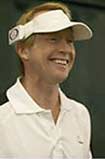 Rhys Thomas
Rhys Thomas
Rhys Thomas is a 25-year USPTA professional, Black Belt in Tae Kwon Do, and a member of the National Head/Penn advisory staff.
He was instrumental in the development of the Ultimate Balance Trainer (www.ultimatebalance.com) as a balance-teaching tool for tennis professionals and other athletic coaches.
Rhys has been Director of Tennis at the Dedham Country and Polo Club in Dedham, Massachusetts, for the last 15 years.

